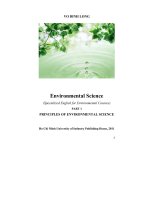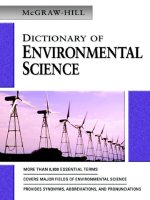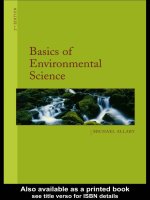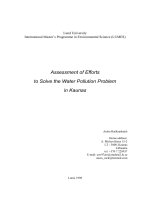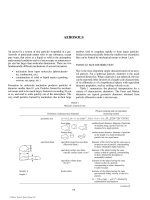Environmental science Demystified
Bạn đang xem bản rút gọn của tài liệu. Xem và tải ngay bản đầy đủ của tài liệu tại đây (2.15 MB, 427 trang )
ENVIRONMENTAL SCIENCE
DEMYSTIFIED
LINDA D. WILLIAMS
McGRAW-HILL
New York Chicago San Francisco Lisbon London
Madrid Mexico City Milan New Delhi San Juan
Seoul Singapore Sydney Toronto
Copyright © 2005 by The McGraw-Hill Companies, Inc. All rights reserved. Manufactured in the United States of
America. Except as permitted under the United States Copyright Act of 1976, no part of this publication may be
reproduced or distributed in any form or by any means, or stored in a database or retrieval system, without the prior
written permission of the publisher.
0-07-147140-5
The material in this eBook also appears in the print version of this title: 0-07-145319-9.
All trademarks are trademarks of their respective owners. Rather than put a trademark symbol after every occurrence of a trademarked name, we use names in an editorial fashion only, and to the benefit of the trademark owner,
with no intention of infringement of the trademark. Where such designations appear in this book, they have been
printed with initial caps.
McGraw-Hill eBooks are available at special quantity discounts to use as premiums and sales promotions, or for use
in corporate training programs. For more information, please contact George Hoare, Special Sales, at
or (212) 904-4069.
TERMS OF USE
This is a copyrighted work and The McGraw-Hill Companies, Inc. (“McGraw-Hill”) and its licensors reserve all
rights in and to the work. Use of this work is subject to these terms. Except as permitted under the Copyright Act
of 1976 and the right to store and retrieve one copy of the work, you may not decompile, disassemble, reverse
engineer, reproduce, modify, create derivative works based upon, transmit, distribute, disseminate, sell, publish or
sublicense the work or any part of it without McGraw-Hill’s prior consent. You may use the work for your own
noncommercial and personal use; any other use of the work is strictly prohibited. Your right to use the work may be
terminated if you fail to comply with these terms.
THE WORK IS PROVIDED “AS IS.” McGRAW-HILL AND ITS LICENSORS MAKE NO GUARANTEES OR
WARRANTIES AS TO THE ACCURACY, ADEQUACY OR COMPLETENESS OF OR RESULTS TO BE
OBTAINED FROM USING THE WORK, INCLUDING ANY INFORMATION THAT CAN BE ACCESSED
THROUGH THE WORK VIA HYPERLINK OR OTHERWISE, AND EXPRESSLY DISCLAIM ANY
WARRANTY, EXPRESS OR IMPLIED, INCLUDING BUT NOT LIMITED TO IMPLIED WARRANTIES OF
MERCHANTABILITY OR FITNESS FOR A PARTICULAR PURPOSE. McGraw-Hill and its licensors do not
warrant or guarantee that the functions contained in the work will meet your requirements or that its operation will
be uninterrupted or error free. Neither McGraw-Hill nor its licensors shall be liable to you or anyone else for any
inaccuracy, error or omission, regardless of cause, in the work or for any damages resulting therefrom. McGrawHill has no responsibility for the content of any information accessed through the work. Under no circumstances
shall McGraw-Hill and/or its licensors be liable for any indirect, incidental, special, punitive, consequential or
similar damages that result from the use of or inability to use the work, even if any of them has been advised of the
possibility of such damages. This limitation of liability shall apply to any claim or cause whatsoever whether such
claim or cause arises in contract, tort or otherwise.
DOI: 10.1036/0071453199
This book is dedicated to the environmental heroes
of the past 200 years, who had the vision, courage,
and quiet persistence to preserve pristine forests,
open lands, and endangered species,
as well as bring pollution issues into general view.
Because of their efforts, we have a good chance
of surviving our global growing pains.
Thank you.
Linda D. Williams
This page intentionally left blank
For more information about this title, click here
CONTENTS
Preface
Acknowledgments
ix
xiii
PART ONE:
ATMOSPHERE
1
CHAPTER 1
Our Planet Earth
3
CHAPTER 2
Ecosystems and Biodiversity
21
CHAPTER 3
Atmosphere
41
CHAPTER 4
Greenhouse Effect and Global Warming
73
Part One Test
91
PART TWO:
WATER
99
CHAPTER 5
The Hydrologic Cycle
101
CHAPTER 6
Oceans and Fisheries
125
CHAPTER 7
Glaciers
147
CHAPTER 8
Water Pollution and Treatment
171
Part Two Test
193
vii
viii
CONTENTS
PART THREE:
LAND
201
CHAPTER 9
Weathering and Erosion
203
CHAPTER 10
Deserts
221
CHAPTER 11
Geochemical Cycling
243
CHAPTER 12
Solid and Hazardous Waste
261
Part Three Test
277
PART FOUR:
WHAT CAN BE DONE
285
CHAPTER 13
Fossil Fuels
287
CHAPTER 14
Nuclear and Solar Energy
303
CHAPTER 15
Wind, Hydroelectric and
Geothermal Energy
319
Future Policy and Alternatives
335
Part Four Test
351
Final Exam
359
Answers to Quiz, Test, and
Exam Questions
377
APPENDIX I
Terms and Organizations
383
APPENDIX II
Conversion Factors
393
References
395
Index
401
CHAPTER 16
PREFACE
This book is for anyone with an interest in Environmental Science who wants to
learn more outside of a formal classroom setting. It can also be used by homeschooled students, tutored students, and those people wishing to change careers.
The material is presented in an easy-to-follow way and can be best understood
when read from beginning to end. However, if you just want more information
on specific topics like greenhouse gases, geothermal energy, or glaciers, then
you can review those chapters individually as well.
You will notice through the course of this book that I have mentioned
milestone theories and accomplishments of geologists and ecologists along
with national and international organizations making a difference. I’ve highlighted these innovative people and agencies to give you an idea of how the
questions and strong love of nature have motivated individuals and countries to
take action.
Science is all about curiosity and the desire to find out how something happens. Nobel prize winners were once students who daydreamed about new ways
of doing things. They knew answers had to be there and they were stubborn
enough to dig for them. The Nobel prize for Science has been awarded over 475
times since 1901.
In 1863, Alfred Nobel experienced a tragic loss in an experiment with nitroglycerine that destroyed two wings of the family mansion and killed his younger
brother and four others. Nobel had discovered the most powerful weapon of that
time—dynamite.
By the end of his life, Nobel had 355 patents for various inventions. After his
death in 1896, Nobel’s will described the establishment of a foundation to create five prizes of equal value “for those who, in the previous year, have contributed best towards the benefits for humankind,” in the areas of Earth Science,
Physics, Physiology/Medicine, Literature, and Peace. Nobel wanted to recognize the heroes of science and encourage others in their quest for knowledge.
Perhaps the simple ideas that changed our understanding of the Earth, ecosys-
ix
Copyright © 2005 by The McGraw-Hill Companies, Inc. Click here for terms of use.
x
PREFACE
tems, and biodiversity will encourage you to use your own creative ideas in tackling important Environmental Science concerns.
This book provides a general overview of Environmental Science with chapters on all the main areas you’ll find in an Environmental Science classroom or
individual study of the subject. The basics are covered to familiarize you with
the terms and concepts most common in the experimental sciences, of which
Environmental Science is one. Additionally, I’ve listed helpful Internet sites with
up-to-date information on global warming, atmospheric factors, and energy
alternatives, to name a few.
Throughout the text, I’ve supplied lots of everyday examples and illustrations of natural events to help you visualize what is happening beneath, on, or
above the Earth’s surface. There are also quiz, test, and exam questions
throughout. All the questions are multiple-choice and a lot like those used in
standardized tests. There is a short quiz at the end of each chapter. These
quizzes are “open book.” You shouldn’t have any trouble with them. You can
look back at the chapter text to refresh your memory or check the details of a
natural process. Write your answers down and have a friend or parent check
your score with the answers in the back of the book. You may want to linger in
a chapter until you have a good handle on the material and get most of the
answers right before moving on.
This book is divided into four major parts. A multiple-choice test follows
each of these parts. When you have completed a part, go ahead and take the part
test. Take the tests “closed book” when you are confident about your skills on
the individual quizzes. Try not to look back at the text material when you are taking them. The questions are no more difficult than the quizzes, but serve as a
more complete review. I have thrown in lots of wacky answers to keep you
awake and make the tests fun. A good score is three-quarters of the answers
right. Remember, all answers are in the back of the book.
The final exam at the end of the course is made up of easier questions than
those in the quizzes and part tests. Take the exam when you have finished all the
chapter quizzes and part tests and feel comfortable with the material as a whole.
A good score on the exam is at least 75% of correct answers.
With all the quizzes, part tests, and the final exam, you may want to have
your friend or parent give you your score without telling you which of the questions you missed. Then you will be tempted not to memorize the answers to
the missed questions, but instead to go back and see if you missed the point of
the idea. When your scores are where you’d like them to be, go back and check
the individual questions to confirm your strengths and any areas that need
more study.
xi
PREFACE
Try going through one chapter a week. An hour a day or so will allow you
to take in the information slowly. Don’t rush. Environmental Science is not difficult, but does take some thought to get the big picture. Just plow through at a
steady rate. If you’re really interested in deserts, spend more time on Chapter
10. If you want to learn the latest about the oceans and fisheries, allow more
time for Chapter 6. At a steady pace, you’ll complete the course in a few months.
After completing the course, you will have become a geologist-in-training. This
book can then serve as a ready reference guide, with its comprehensive index,
appendix, and many examples of cloud structures, energy types, erosion, and
geochemical cycling.
Suggestions for future editions are welcome.
LINDA D. WILLIAMS
This page intentionally left blank
ACKNOWLEDGMENTS
Illustrations in this book were generated with CorelDRAW and Microsoft
PowerPoint and Microsoft Visio, courtesy of the Corel and Microsoft Corporations, respectively.
National Oceanographic and Atmospheric Administration (NOAA), Environmental Protection Agency (EPA), and United States Geological Survey (USGS)
statistics and forecasts were used where indicated.
A very special thanks to Dr. Karen Duston of Rice University for the technical review of this book.
Many thanks to Judy Bass at McGraw-Hill for her unfailing confidence and
assistance.
Thank you also to Rice University’s staff and faculty for their friendship, support, and flexibility in the completion of this work.
To my children, grandchildren, and great-grandchildren who will inherit the
Earth that is left to them.
xiii
Copyright © 2005 by The McGraw-Hill Companies, Inc. Click here for terms of use.
This page intentionally left blank
ENVIRONMENTAL SCIENCE
DEMYSTIFIED
This page intentionally left blank
PART ONE
Atmosphere
Copyright © 2005 by The McGraw-Hill Companies, Inc. Click here for terms of use.
This page intentionally left blank
CHAPTER
1
Our Planet Earth
Native peoples, completely dependent on nature for everything in their lives, worshipped Earth as a nurturing mother. The soil sprouted plants and trees that provided food, clothing, and shelter. The rivers and seas gave up fish and shellfish for
food, trade articles, and tools. From the atmosphere came rain, snow, and wind to
water crops and adjust the seasons. Earth, never stagnant or dull, provided abundantly for early stewards of her resources. Ancient peoples thought that Mother
Earth worked together with Father Sun to provide for those who honored her.
In early Greek mythology, the Earth goddess, Gaia, mother of the Titans, was
honored as an all-nourishing deity. When Gaia was happy, crops flourished, fishermen and hunters were successful, and everything thrived.
Today, astronauts who orbit Earth in space ships and scientific laboratories
marvel at her beauty while working toward her care. Other scientists, engineers,
and test pilots have communicated their wonder and appreciation for our fragile
world through environmental efforts that address global issues. Any study of the
environment includes many facets of this planet we call home. Environmental
science encompasses worldwide environmental factors like air, light, moisture,
temperature, wind, soil, and other living organisms.
Environmental biology includes all the external factors that affect an
organism or community and that influence its development or existence.
3
Copyright © 2005 by The McGraw-Hill Companies, Inc. Click here for terms of use.
4
PART ONE
Atmosphere
The Earth’s almost limitless beauty and complexity provide broad areas for
scientific study. Researchers from many different fields are focusing their skills
on the mechanisms and interactions of hundreds of environmental factors. These
natural and industrial factors affect the environment in ways that are known and
suspected, as well as those totally unidentified. Although some changes have
been taking place for millions of years, some appear to be accelerating. Today,
environmental scientists are sorting through tons of data in order to increase their
understanding of the impacts of modern processes on all environmental aspects.
Table 1-1 lists a sampling of the various environmental fields of scientific study.
Size and Shape
The size and shape of the earth was a mystery for thousands of years. Most people thought the land and seas were flat. They were afraid that if they traveled too
far in one direction, they would fall off the edge. Explorers who sailed to the limits of known navigation were considered crazy and on paths to destruction. Since
many early ships did not return from long voyages, people thought they had
been sunk by storms, eaten by sea monsters, or just went too far and fell off.
It wasn’t until the Greek philosopher Aristotle (384–322 BC), who noticed that
Earth’s shadow on the moon was curved, that people began to question the “flat
earth” idea. It was another 1500 years, however, before the earth’s round shape
was well understood.
Compared to the sun, which is over 332,000 times the mass of the Earth, our
home planet is tiny—a bit like a human compared to an ant. The sun is 1,391,000
kilometers in diameter compared to the Earth, which is approximately 12,756 km
in diameter. That means the diameter of the sun is over 100 times that
of the Earth. To picture the size difference, imagine that the sun is the size of a
basketball. By comparison, the earth would be about the size of this “o.”
Earth’s Formation
In 1755, Immanuel Kant offered the idea that the solar system was formed from
a rotating cloud of gas and thin dust. In the years since, this idea has become
known as the nebular hypothesis. The clouds that Kant described could be seen
CHAPTER 1
Our Planet Earth
Table 1-1 Fields of study.
Environmental
science
Area of interest
Agrology
Analysis and management of usable land for growth
of food crops
Bioengineering
Designing or reconstructing sustainable ecosystems
Botany
Characterization, growth, and distribution of plants
Conservation
biology
Preserve, manage, or restore endangered areas or species
Ecology
Study of relationships between living organisms and their
environment
Environmental
geology
Conservation of resources and future planning
Exploration
geophysics
Crustal composition to find resources (e.g. oil, gold)
Forestry
Characterization, growth, distribution, and planting of trees
Geochemistry
Chemical composition of rocks and their changes
Geomorphology
Nature, origin, development, and surface of land forms
Geophysics
Earth’s magnetism, gravity, electrical properties, and
radioactivity
Glaciology
Formation, movement, and makeup of current glaciers
Hydrology
Composition and flow of water over the earth
Mineralogy
Natural and synthetic minerals with a crystalline structure
Oceanography
Water makeup, currents, boundaries, topography, marine life
Pedology
Origin, treatment, character, and utilization of soil
Petrology
Origins, composition, alteration, and decay of rock
Structural geology
Rock changes and distortions within the earth’s layers
Volcanology
Formation, activity, temperature, and explosions of volcanoes
Wildlife biology
Characterization and distribution of animal communities
Zoology
Characterization, growth, and distribution of animals
5
6
PART ONE
Mantle
(2,900 km)
Liquid outer core
(5,150 km; iron,
nickel, silicon,
sulfur, and oxygen)
Atmosphere
Solid inner core
(6,440 km; iron)
Oceanic
crust
(105 km)
Continental crust
(200 km)
Fig. 1-1 The Earth has four main layers.
by powerful telescopes. The NASA Hubble space telescope has sent back
images of many of these beautiful formations, called nebulae.
It is likely that when the Earth was first forming in our young solar neighborhood, it was a molten mass of rock and metals simmering at about 3,600°
Fahrenheit (2,000° Celsius). The main cloud elements included hydrogen,
helium, carbon, nitrogen, oxygen, silicon, iron, nickel, phosphorus, sulfur, and
others. As the sphere (Earth) cooled, the heavier metals like iron and nickel sunk
deeper into the molten core, while the lighter elements like silicon rose to the
surface, cooled a bit, and began to form a thin crust. Fig. 1-1 shows the way that
early elements formed into a multilayer crust. This crust floated on a sea of
molten rock approximately four billion years ago, sputtering volcanic gases and
steam from the impact of visitors like ice comets. Millions more years passed
like this while an atmosphere gradually formed. Rain condensed and poured
down, cooling the crust into one large chunk and gathering into low spots and
cracks, forming oceans, seas, lakes, rivers, and streams.
Our Place in the Galaxy
Even though the sun seems to be the center of our universe, it is really just one
of many kids on the block. Our solar system is found on one of the spiral arms,
Orion, of the galaxy known as the Milky Way.
CHAPTER 1
7
Our Planet Earth
The Milky Way is one of millions of galaxies in the universe. The
Andromeda galaxy is the nearest major galaxy to the Milky Way.
Think of the Milky Way galaxy as one “continent” among billions of other
continents in a world called the universe. Its spiraling arms or “countries” are
called Centaurus, Sagittarius, Orion, Perseus, and Cygnus. The Milky Way
galaxy is 80,000 to 120,000 light years across (a light year is a measure of
distance equal to or more than 9 trillion km, or 9.46 × 1012 km). The center
of the Milky Way is made up of a dense molecular cloud that rotates slowly
clockwise, throwing off solar systems and cosmic debris. It contains roughly
200 billion (2 × 1012) stars.
Although Andromeda is the closest full-size galaxy to the Milky Way, the
Sagittarius Dwarf, discovered in 1994, is the closest galaxy. It is 80,000 light
years away, or nearly 24 kiloparsecs. A parsec is a unit of measurement equal to
3.26 light years.
Atmosphere
Earth’s atmosphere is the key to the development of life on this planet. Other
planets in our solar system contain various levels of hydrogen, methane, and
ammonia atmospheres (Jupiter, Neptune), carbon dioxide and nitrogen (Venus,
Mars), or hardly any atmosphere at all (Mercury, Pluto).
The atmosphere of the Earth, belched from prehistoric volcanoes, extends
nearly 563 km (350 miles) out from the solid surface of our planet. It is made
up of a mixture of gases that combine to allow life to exist. In the lower atmosphere, nitrogen is found in the greatest amounts, 78%, followed by oxygen at
21%. Carbon dioxide, vital to the growth of plants, is present in trace levels of
atmospheric gases, along with argon and a sprinkling of neon and other minor
gases. Table 1-2 compares the earth’s atmosphere with the atmosphere of neighboring planets.
Oxygen, critical to human life, developed as microscopic plants and algae
began using carbon dioxide and photosynthesis to make food. From that process,
oxygen is the most important byproduct.
The mixture of gases that we call air penetrates the ground and most openings
in the earth not already filled with water. The atmosphere is perhaps the most
active of the different environmental components. To people around the world,
it has a constantly changing personality.
8
PART ONE
Atmosphere
Table 1-2 Planets, atmospheric gases.
Planets
Atmospheric gases
Sun
Hydrogen, nitrogen
Mercury
None
Venus
None
Earth
Oxygen, nitrogen,
hydrogen
Mars
None
Jupiter
Methane, hydrogen
Saturn
Hydrogen, methane
Uranus
None
Neptune
None
Pluto
None
We will study these atmospheric factors that favor life on Earth when we take
a closer look at the atmosphere in Chapter 3.
Gaia Hypothesis
In 1974, James Lovelock explained that the Earth existed as a single living organism in his Gaia hypothesis. He described how organic and inorganic components
interact through complex reactions to balance an environment where life can
exist. Lovelock’s Gaia theory considers the evolution of a tightly integrated system made up of all living things and the physical environment: the atmosphere,
oceans, and land. Natural regulation of important factors, like climate and chemical composition, is a result of intricate evolutionary development. Like many living organisms and closed-loop self-regulating systems, Lovelock considered Gaia
as one system in which the whole is greater than the sum of its parts.
CHAPTER 1
Our Planet Earth
An active, adaptive control process, able to maintain the Earth in overall balance, is known as the Gaia hypothesis.
Today, there is heated debate about which global environmental problem is
the most crucial. Depending on a person’s geographical and economic position,
it can be pollution, overpopulation, ozone depletion, deforestation, habitat
destruction, global warming, overfishing, drought, radioactive waste storage—
or all or none of these. Some scientists believe that these environmental impacts
will be overcome in the long run when Gaia makes the corrections needed to
bring the Earth back into equilibrium.
The problem with these balancing forces is that they can be sudden and violent (think earthquakes and volcanic eruptions). A powerful, natural environmental adjustment often brings disaster upon all inhabitants unfortunate enough
to be in the vicinity.
In 1979, Lovelock further described his theory in GAIA: A New Look at Life
on Earth. Since then, many scientists and environmentalists have begun to study
global changes within the context of the Gaia idea, although not everyone agrees
with the theory.
The updated Gaia hypothesis proposes that Earth’s atmosphere, oceans, and
land masses are held in equilibrium by the living inhabitants of the planet, which
includes millions of species besides humans. The Gaia concept suggests that this
living world keeps itself in worldwide environmental balance.
One example of this balancing act takes place in the oceans. Salts are constantly added to the oceans by physical and chemical processes, raising salinity.
Eventually, affected seas (like the Dead Sea) reach an uninhabitable salinity
level. According to the Gaia hypothesis, the sea’s salinity is controlled biologically through the mutual action of ocean organisms. In fact, living sea creatures,
primarily algae and protozoa, have processed and removed salt throughout geological time, balancing salinity levels that allow life to thrive.
Actually, that is fairly straightforward. Salt is removed from ocean waters when
it piles up on the bottom. This happens following the death of microorganisms
that sink to the ocean floor. As ocean salinity rises, plankton that include salt
into their outer coverings die and sink to the ocean depths, lowering salt levels.
In this way, the ocean’s salinity stays in equilibrium.
The Gaia theory can also be applied to the balancing of atmospheric gases
in fairly constant proportions needed to support life. Without the ongoing biological creation of oxygen and methane, for example, the balance of critical
atmospheric elements would be severely altered. Organisms all over the
9
10
PART ONE
Atmosphere
world work together to create a breathable atmosphere, not just in one habitat
or location.
Scientists questioning the Gaia concept think that evolutionary changes
account for the adjustments needed for life to exist. The argument goes that when
ocean salinity increases, oxygen levels change or global temperatures increase.
Only evolved organisms are able to able to survive new conditions, and their
genetically stronger offspring are then able to thrive in a changed environment.
Lovelock counters this by stressing that environmental conditions can’t operate independently of living world processes. Table 1-3 lists the diverse Earth
energy resources and processes to be considered.
In the Gaia concept, humans are seen as one species among millions, with
no special rights. Whether humans were here or not makes little difference
to Gaia’s survival, which eventually adjusts for overpopulation, global warming, or habitat destruction. Some might even argue that Gaia would function
Table 1-3
Energy resources.
Solar energy
Fossil fuels
Atmospheric absorption
Surface heating
Wind energy
Heat from the earth’s core
Shortwave and longwave
radiation
Flowing rivers
Hydrologic cycle
and precipitation
Tidal energy
Gravitational energy
Tectonic energy
Energy absorption in the
earth’s crust
CHAPTER 1
11
Our Planet Earth
more effectively without us here at all. However, whether humans are responsible for environmental problems or not, global balancing may severely impact
our future.
To understand the Earth as one living system (whether called Gaia or something else) we need to understand more about all the parts that make it unique.
Biosphere
All plants and animals on the earth live in the biosphere, which is measured from
the ocean floor to the top of the atmosphere. It includes all living things, large
(whales) and small (bacteria), grouped into species or separate types. The main
compounds that make up the biosphere contain carbon, hydrogen, and oxygen.
These elements also interact with other earth systems.
The biosphere includes the hydrosphere, crust, and atmosphere. It is
located above the deeper layers of the earth.
Surprisingly, life is found in many hostile environments on this planet. Very
hot temperatures (5,000°C) near volcanic spouts rising from the ocean floor, and
polar, subzero temperatures (−84°C) are at the extreme ends of the temperature
range. The earth’s biodiversity is truly amazing. Everything from exotic and
fearsome deep-ocean creatures to sightless fish in underground lakes exists as
part of the earth’s diverse inhabitants. There are sulfur-fixing bacteria that thrive
in sulfur-rich, boiling geothermal pools and frogs that dry out and remain barely
alive in desert soils until the rare rains bring them back to life. This makes environmental study fascinating to people of all cultures, geographies, and interests.
However, the large majority of biosphere organisms that grow, reproduce, and
die are found in a much more narrow range. In fact, most of the Earth’s species
live in a thin slice of the biosphere. This slice is located at temperatures above
zero (most of the year) and in upper ocean depths where sunlight can penetrate.
The vertical range of the biosphere is roughly 20,000 meters, but the section
most populated with living species is only a fraction of that. It includes a section
measured from just below the ocean’s surface to about 1,000 meters above it.
Most living plants and animals live in this narrow layer of the biosphere. The
biosphere and the impacts of today’s world will be described in greater detail in
Chapter 2.
